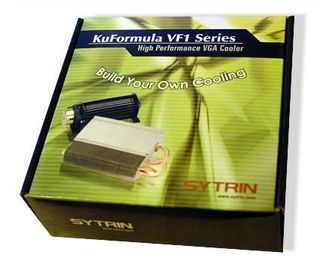Is the KuFormula VF1 Plus the Magic Bullet for Graphics Cooling?
Overview

When it comes to squeezing more performance out of a gaming PC, there are two related items that immediately demand more attention than anything else in the case: CPU temperature and graphics processor temperature. Of the two, CPUs tend to get more attention; inevitably, however, all of the cooling lessons learned in the CPU arena trickle down to the graphics processor as well.
The matter of graphics processor cooling has never been more important than it is today, as the transistor count of graphics processors is increasing much faster than that of CPUs. Thanks to the never-ending intense competition between the two heavyweights - you know who they are - newer, faster graphics processors are introduced at a breakneck pace, and traditional cooling methods are beginning to show their age.
The heat pipe cooling technology that is now commonly used in the top CPU air coolers was once an elite solution reserved for video card owners who demanded the quietest cooling systems. Now heat pipes are becoming more and more common in aftermarket replacement VGA coolers. In this article we will review one of these coolers: the Sytrin KuFormula VF1 Plus.
The test card is an ATI All-In-Wonder X1800 XL. Typical of the newer generation of graphics chipsets from ATI and Nvidia, the X1800 series has more transistors than anything AMD or Intel has to offer. While this is great for performance, it is bad for heat generation. Since the XL isn't a 'top tier' solution, it is offered with a simple, single-slot cooler that is only up to the task at stock clock speeds. The result is that a stock X1800 XL can reach temperatures exceeding 80°C Celsius (176°F) under load - a mere 20°C from the boiling point. For the enthusiast, this is an alarm bell that simply can't be ignored.
Although the VF1 Plus has a flexible mounting system that supports most graphics cards on the market today, it did not officially support the new Radeon 1800 and X1900 video cards when the testing for this review was performed. Therefore, in addition to measuring the cooler's performance, our review included an assessment of what it would take to adapt the VF1 Plus to the All-In-Wonder X1800 XL.
The MSRP of only $38 sounds very appealing, but how flexible is the VF1 Plus hardware at adapting to new hardware configurations? And how well can it cool down one of today's hottest graphics processors when pushed to the limit? Let's find out.
Stay on the Cutting Edge
Join the experts who read Tom's Hardware for the inside track on enthusiast PC tech news — and have for over 25 years. We'll send breaking news and in-depth reviews of CPUs, GPUs, AI, maker hardware and more straight to your inbox.
Most Popular

